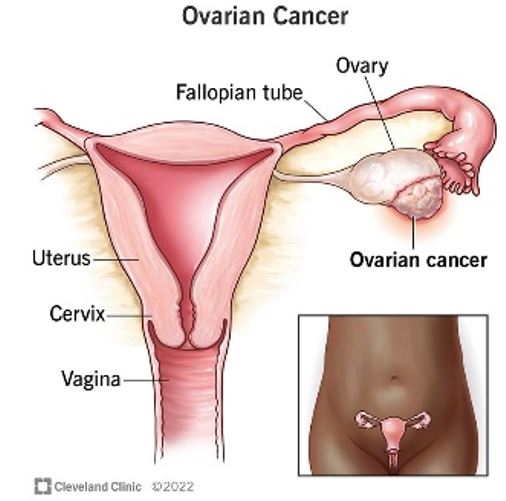

11th September 2024 (9 Topics)
Context
Ovarian cancer is one of the most deadly forms of gynecological cancer, often termed a “silent killer” due to its vague symptoms and late diagnosis
About
- Ovarian cancer occurs when abnormal cells in ovaries or fallopian tubes grow and multiply out of control.
- Ovariesare part of the female reproductive system. These two round, walnut-sized organs make eggs during reproductive years.
- Cancer Subtypes:
- Type I Tumors: Less common, typically diagnosed early, and have a better prognosis.
- Type II Tumors: More aggressive, commonly diagnosed at advanced stages, and responsible for most deaths.
- Common Symptoms: Include bloating, pelvic or abdominal pain, loss of appetite, feeling full quickly, frequent urination, indigestion, constipation, back pain, fatigue, weight loss, and postmenopausal bleeding.
- Diagnostic Challenges: These symptoms often mimic less serious conditions, leading to delayed diagnosis. A 2004 study noted that women with malignant ovarian cancer experience these symptoms 20-30 times a month, more severely compared to those without the disease.
- Screening Challenges: There are no effective routine screening tests for ovarian cancer. The CA125 blood test is not recommended for general screening due to its low specificity and potential for false positives.
- Risk Factors
-
- Genetics: BRCA1 and BRCA2 Mutations significantly increase the risk of ovarian cancer (up to 50% for BRCA1 and around 15% for BRCA2).
- Endometriosis: Women with endometriosis have a higher risk of developing certain types of ovarian cancer, though the risk is relatively low.
- Hormone Replacement Therapy (HRT), used for menopausal symptoms, has been associated with a higher risk of ovarian cancer, even with short-term use.
- Unhealthy lifestyle
- The Gravity of Ovarian Cancer
-
- Prevalence in India: Ovarian cancer ranks among the top three cancers in Indian women, contributing to 6.6% of all female cancer cases.
- Incidence and Mortality: In 2022, India reported 47,333 new cases and 32,978 deaths due to ovarian cancer.
More Articles




